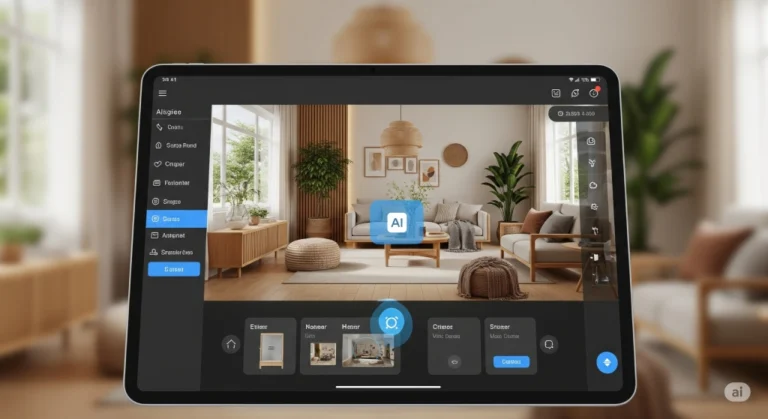Imagine walking into your apartment, scanning the space with your phone, and getting a fully designed room layout complete with color palettes, furniture suggestions, and lighting tweaks—all generated by artificial intelligence in seconds. Welcome to AI for interior design in 2025, where technology is redefining how we style our living spaces.
But the big question remains: can a bot really make your space beautiful? Let’s explore how AI is revolutionizing interior design—and whether it has the eye for detail to replace human creativity.
How AI Is Being Used in Interior Design Today
The role of AI in interior design has evolved rapidly thanks to advancements in computer vision, machine learning, and generative design tools. Here’s what AI can do in 2025:
1. Room Scanning and Spatial Mapping
AI apps like Planner 5D or RoomGPT allow users to scan their room with a smartphone and instantly generate 3D layouts. The AI analyzes wall lengths, ceiling height, window placement, and more—turning your phone into a virtual measuring tape.
2. Style Recognition and Theme Suggestions
By analyzing photos of your space and your Pinterest boards or saved Instagram posts, AI can identify your preferred style—be it Scandinavian minimalism or Boho chic—and suggest matching elements.
3. Color Matching and Palette Generation
AI tools can generate color schemes based on the mood you want. Want a calm reading nook? The bot may suggest muted greens, beiges, and soft textures. Need a vibrant office? Expect coral, teal, or mustard accents.
4. Furniture and Decor Placement
Based on traffic flow and room function, AI now suggests ideal placement for sofas, shelves, lighting fixtures, and rugs—maximizing both beauty and utility.
5. Virtual Staging for Real Estate
For agents and home sellers, AI tools like roOomy and Styldod offer AI-based staging—adding virtual furniture and décor to empty homes to help them sell faster.
Can AI Really “Design” Like a Human?
This is the heart of the debate. While AI is incredibly efficient, is it aesthetic?
Pros:
- ✅ Speed: AI can generate 5 different design layouts in under a minute.
- ✅ Cost-Effective: No need to hire a $100/hour interior designer.
- ✅ Personalized Suggestions: AI learns your taste via style quizzes and image analysis.
- ✅ Data-Driven: AI considers light flow, symmetry, feng shui principles, and ergonomic design.
Cons:
- ❌ Creativity Limits: AI follows patterns. It doesn’t invent new design languages.
- ❌ Context Blindness: It may not account for personal stories (heirlooms, emotional items).
- ❌ No Sensory Feedback: It can’t feel texture or smell finishes.
- ❌ Limited Human Empathy: AI might suggest a glass coffee table to a house with toddlers—stylish, but not smart.
Top AI Interior Design Tools in 2025
Here are the top AI tools that are disrupting interior design:
| Tool | Best For | Features |
|---|---|---|
| Havenly AI | Room planning & furniture matching | AI stylist + real human collaboration |
| Planner 5D AI | 3D Room visualization | Scans real rooms & simulates furniture |
| DecorMatters | iOS/Android app with AR | Mood boards, brand integration |
| RoomGPT | Free layout suggestions | Upload your room photo to get ideas |
| Modsy | Virtual staging & e-design | AI + human hybrid approach |
| IKEA Kreativ | Smart product suggestions | Scan room and add IKEA furniture virtually |
How AI Matches Your Personality to Design
Many 2025 tools use personality-style matching. You answer a few questions or upload mood board samples, and AI categorizes you into profiles like:
- “Earthy Sophisticate” – Lots of terracotta, stone, and greenery
- “Urban Visionary” – High contrast, concrete, industrial flair
- “Soft Modernist” – White space, subtle shapes, Zen feel
The AI then builds complete design themes around these identities—saving hours of Pinterest rabbit holes.
Real-Life Examples: AI in Action
Case Study 1: First Apartment Glow-Up
Jade, a 25-year-old teacher in New York, used IKEA Kreativ to design her first studio apartment. In under 30 minutes, she scanned her room, chose a minimalist layout, and virtually placed every item. The best part? She could order everything in one click.
Case Study 2: Virtual Staging for Real Estate
An agent in Austin used Styldod to stage an empty home virtually for $29. The result? The house got 3X more online interest and sold in under 6 days.
What the Future Holds: AI + AR + Smart Homes
The future of AI in interior design lies at the intersection of:
- AI + AR: You’ll walk through your space wearing Apple Vision Pro and see AI-generated décor overlaid in real time.
- Smart Homes: AI will sync with smart lighting, thermostats, and music to create mood-responsive environments.
- Generative Design: Think Midjourney or DALL·E—but for interiors. Describe your dream kitchen in words, and the AI will visualize it in seconds.
Will AI Replace Human Designers?
No—but it will redefine their role.
Much like how architects now use CAD or artists use digital brushes, interior designers will use AI as a collaborative tool. Designers can spend less time on repetitive tasks and more on high-level creative storytelling.
Think of AI as the assistant—not the artist.
Final Thoughts: Can a Bot Really Beautify Your Space?
Yes—if beauty means efficiency, cohesion, and tailored design. But if beauty also means sentiment, experimentation, and emotional warmth, human designers still have the upper hand.
That said, the line between bot and human creativity continues to blur. And maybe, just maybe, your next dream room will come not from a designer’s sketchbook—but from an algorithm’s imagination.


